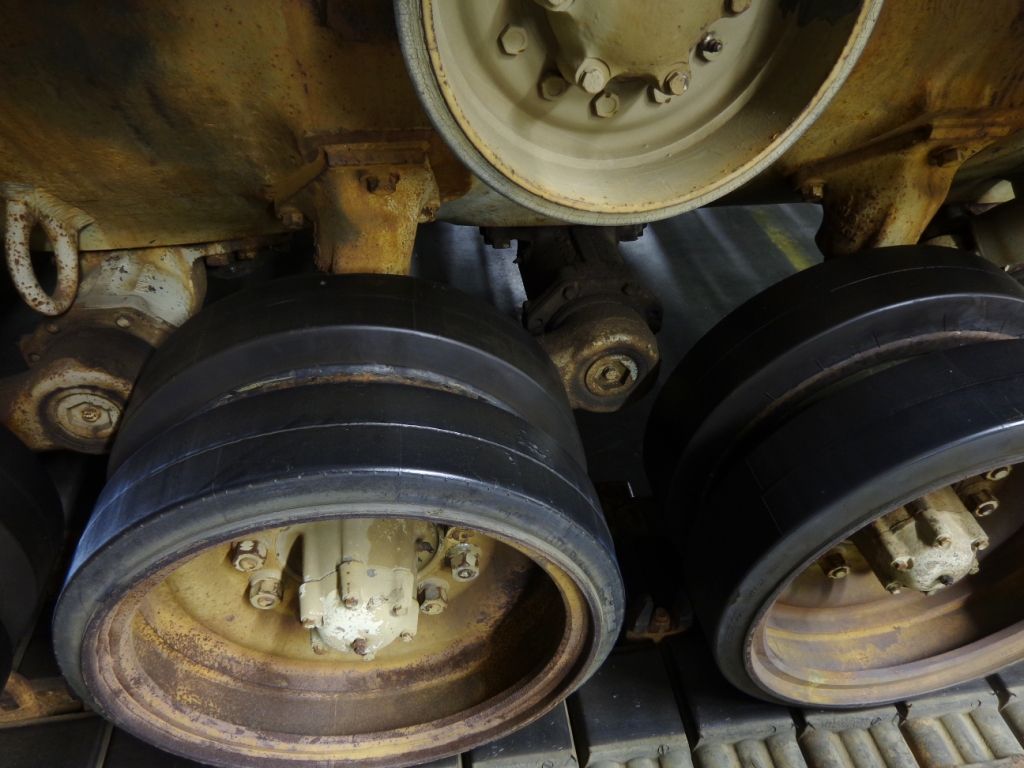Hey guys and gals, 
As you know, I've been to the Armor museum two weekends in a row, and took almost 1,000 photos. While I was there, I kept an eye out for the opportunity to photograph photos that would be significant to modelers. I've assembled a good little group of photos here that might help you out.
This thread was also prompted by a recent comment about track detailing on another thread, and about the practice of painting tracks while they were on the model--something that I discouraged because I didn't think you could properly weather the tracks. In some of these photos, you'll see why.
I've got a number of different vehicles and details to show. Enjoy, and take notes! 
In this first one, notice how the Pz IV wheels are leaking lubrication from a bad seal. You can see the subtle staining, Also, notice how beat up the actual wheels are. (And notice how the lube points are called out in red--does anyone know if this was an original characteristic of German panzers? Or do you think tha it was most likely the handiwork of the Czechs who sold it to the Syrians?)

Next, here's the wheels on a modern M110 self-propelled howitzer. Note again, the leaking stains from a bad seal.

Some weathered tools from a White Armored Car--the standard US armored car in WWII.

Notice the variations in tone and color on this tank's finish! This is rather what the "Dot Method" can give you if applied correctly, If nothing else, it informs the discussion on whether or not to weather. Some guys like that "clean" look--but even that can be modulated to a degree.

A few photos of a Sherman M4A3E8's wheels. Check out the wear on them! This can be effected by chipping at the wheels with an Exacto blade.

The wheel on the right bogey here is down to the rim near the bottom!

Seriously--look at this wear! WOW!

By contrast, this is from the M103 tank. Not much wear because of not much use!

Here's a towing shackle of an M48; look at the silvering -- and the old rust--from the wear---both recent, and old.

Here's a rusted muffler from an M44 self-propelled howitzer. Note the color and intensity.

More leaking seals on a T55.

The rust on this bumper testifies that this area got a lot of wear and abuse.

Bullet holes in the sprocket of an M1 Stuart

The M113series is made of aluminum. Therefore, the chipping will be dull silver.

More wear on an M113 variant's towing shackles.

Look at how this M901 (M113 chassis) got its front end chewed up?!

Interesting detail of rubber seal inside an M113 hatch.

This M48A5 in its original paint shows a lot of paint chipping and wear on and under the front bowplate.

See that pipe? That's not to be rusted---it's the exhaust hose for the crew heater or something like that. It doesn't rust like a muffler would. I think I've even made that error!

Bill, the museum's owner, pointing out where the inner faces of the wheels wouldbe silvered and worn where they contact the track guide horns. Yes, he actually spent a lot of time giving me modeling advice! What a great guy, seriously!

This M48A5 Patton had recently been moved---it was used for one of the museum's "Armor Days", where they took it out and crushed a junk car. Notice how the wheels have burnished the inner track faces?

Another cool detail--look at how, on these newer wheels, there is still the molding line on the tires? On older wheels, this is worn right off. Look at the wheel in the upper photo--THAT one is worn down. Normally, I sand this right off when I see it. But maybe it's time to consider the use of whatever vehicle I'm modeling?

Bill was careful to point out the wear on the outside of the track pin links where they would contact the ground? Also, look at the metallic character or the rack guides?

Note the proper points of wear on the sprocket. (Yellow arrows). I can tell you right now that I have weathered these wrong before---just slapping on metallic silver on the whole sprocket edge. Also, the red arrow shows again the burnished character of the track face inside. You just can't get this detail correct when you paint the tracks on the model. It bears mentioning as well that the wheel faces themselves are burnished!
I hope you've enjoyed and learned something from these pics! I have to admit that I myself gained a lot of perspective from the museum and the evidence collected in these photos.
Feel free to leave comments and observations of your own! This could be a very useful thread if everyone contributes! 
